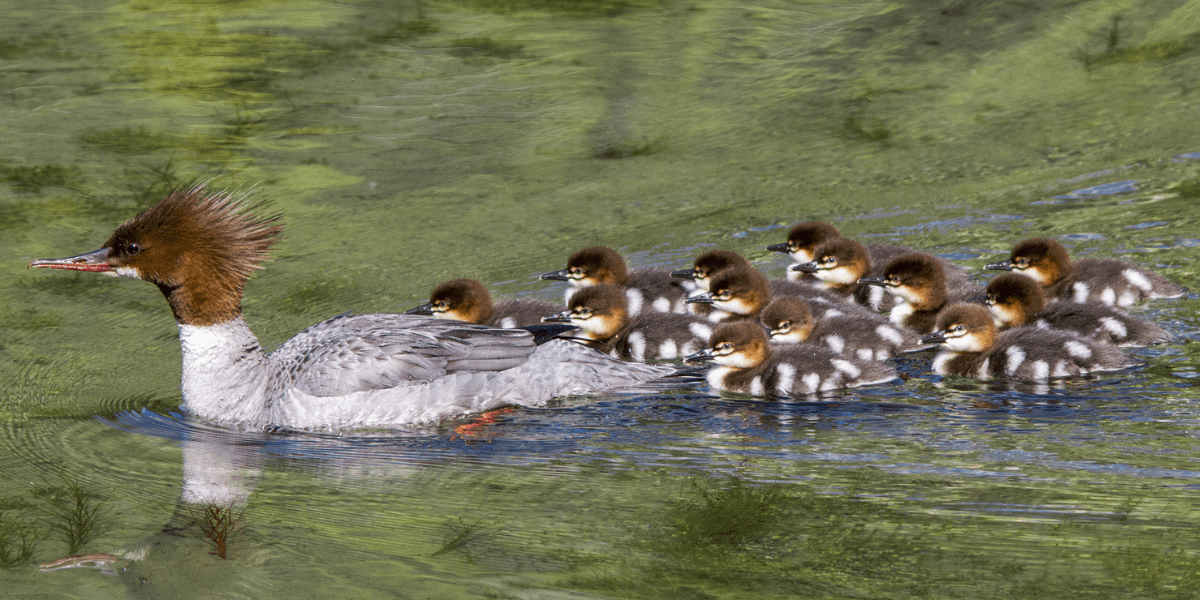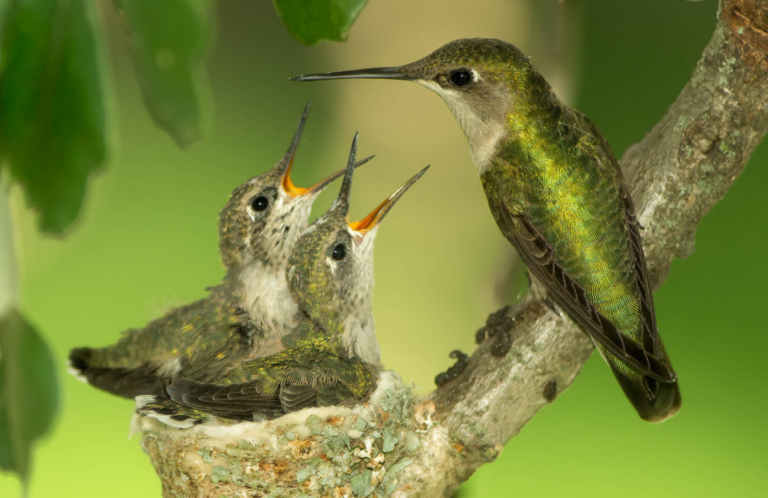A Look Inside the Nest: Female Birds and Parenting

There are seemingly endless ways to raise youngsters in the bird world. Some female birds do it all: building the nest, incubating the eggs, and raising the young to fledging. Others split the work with a male partner. Occasionally, males do all the work. In some rare cases, females and males manage to avoid parenting duties altogether. For some species, it takes a village to help raise chicks, and “neighbors” or even other offspring pitch in.
However they do it, the process of nesting, brooding, and fledging chicks can be an intense experience for birds (and it is often done after a lengthy migration journey!). Explore the parenting strategies of a few female birds to see how different their approaches to raising young can be.
Female Hummingbirds: (Extra) Small, But Mighty
Hummingbirds are astounding in their own right: they are almost unbelievably small, yet some hummingbird species migrate thousands of miles on wings that beat up to 200 times per second. Though male hummingbirds tend to get the credit for their showy, iridescent feathers and impressive courtship flights, females deserve a closer look. Not only are they subtly beautiful, but they are extremely engaged and devoted parents, too.
Male hummingbirds play no role in nesting. Once they have mated, they are gone, leaving the female to do the hard work. She's up to the task, though! Females build nests over several days using soft fibers bound together with spiderwebs, which provide some stretch to accommodate eggs and eventually chicks. A little lichen and moss allow the nest to blend in with the surrounding branches. That is where the female will stay for the next two weeks, approximately, while she incubates two tiny eggs that are the same weight as a paperclip.
Aside from a handful of quick trips each day to grab a bite to eat, the female is on the nest around the clock. Hummingbird chicks are altricial, meaning they cannot survive without significant care from a parent, so when her eggs hatch, the female hummingbird's work is far from done! Though timing varies from one hummingbird species to the next, she can expect to feed hungry nestlings until they fledge after about 25 days. She might even start the process over with a new brood.
Parenting is not a job for the faint of heart, especially in the world of hummingbirds, but quality habitat can make the work easier. American Bird Conservancy and our partners in communities throughout Latin America and the Caribbean have created more than 1 million acres of reserves where upwards of 230 hummingbird species are found. Your yard, too, can become prime hummingbird habitat with the right native plants and the absence of free-roaming cats and pesticides.
In Rain, Sleet, Snow, or Heat, Bald Eagles Deliver for Their Young
Hunkered down with the snow piling up around her, and even on top of her, one Bald Eagle in Minnesota made headlines when she was seen on a livestream nest cam stoically weathering the snowstorm that had rolled in. Thankfully, Bald Eagles are equipped with warm, insulating feathers, and, surprisingly, the snow adds a little insulation to the nest, too. Other Bald Eagles have been seen sitting patiently through torrential downpours and holding steady through hail storms. As long as they are able to carefully rotate their eggs to keep them warm and prevent the nest from getting too wet, these hardy birds of prey will endure whatever nature throws their way.

Bald Eagles build massive nests in tall trees that offer a good view and an easy spot to take off or land. Males and females both bring nesting materials to the site, but it is the female who does most of the arranging, carefully weaving together sticks, moss, cornstalks, and grass to create a nest measuring up to 6 feet in diameter and weighing 1,000 pounds. She then lines the nest with lichen before adding the finishing touches: soft, downy feathers or greenery in the nest cup, the future home of a clutch of up to three eggs. Building the nest can take three months, but it's a worthwhile investment: Bald Eagles reuse the same nest year after year and add to it as they go.
Soon, the pair settle into a routine of shared incubation duties until the eggs hatch. The female is on the nest a majority of the time, which frees up her mate to do the important work of bringing back food for rapidly growing chicks. The female will soon catch up to him, though. Once nestlings no longer require her near-constant presence, she is out on the hunt, supplying her young with as much food as the male.
Bald Eagle nests often make headlines in local news, in part because they were rare only decades ago. In addition to losing habitat, throughout the middle of the 20th century, Bald Eagles suffered greatly from the use of the agricultural pesticide DDT, which thinned the shells of their eggs and led to a quick decline in the species. Bald Eagles have made a remarkable recovery, possible only because of the protections they were afforded under the Endangered Species Act and the banning of DDT in 1972. Their numbers have steadily climbed from an estimated 417 breeding pairs in 1963 to more than 71,000 today.
The Bald Eagle's recovery is one of the strongest examples of conservation at work and a clear signal that we have the capacity to reverse species declines and halt extinctions. Today, a new generation of pesticides continues to threaten birds and other wildlife. Learn more about the problems of pesticides today and take action.
Brown-headed Cowbirds Make Raising Chicks Look Easy …
… Because they simply don't do it! Brood parasitism is an evolutionary strategy that shifts the responsibilities of incubating eggs and caring for young onto another bird — or another species — entirely. Brown-headed Cowbirds initially developed this strategy to allow them the freedom to follow the bison and cattle that roamed the Great Plains, whose footsteps stirred up insects that the cowbirds could eat. Their nomadic existence made nesting nearly impossible. Brood parasitism solved that problem, but as the Brown-headed Cowbird's range has expanded, so has their nesting strategy.
Female Brown-headed Cowbirds lay eggs prolifically at a rate of nearly one egg per day in a breeding season that can last more than two months. While brood parasitism works for cowbirds, it can be detrimental to other species like warblers, vireos, and sparrows. Some species recognize cowbird eggs and remove them if they're large enough to do so, or build a new nest atop the parasitized one, as the Yellow Warbler often does. Typically, though, the eggs are incubated, sometimes at the expense of the host's much smaller eggs. Cowbird eggs hatch quickly, and the comparatively enormous chicks can out-compete other nestlings for food and space.
Alterations to the landscape have exacerbated this problem: Unchecked deforestation paved the way for the cowbird's range to expand beyond the prairies of the Midwest to the entire continental United States. Managing for brood parasitism is part of the recovery plans for some endangered species like the Kirtland's Warbler and Black-capped Vireo, but the cowbird is protected by the Migratory Bird Treaty Act, making it illegal to remove its eggs without a permit.
The best way to keep your yard free of opportunistic Brown-headed Cowbirds is to make it less attractive to them. Reduce the amount of open lawn by growing native plant species in its place. Avoid platform feeders that provide easy perching for cowbirds and clean up bird seed scattered on the ground to deter their foraging.
The Common Merganser: Mother to Multitudes
If you've ever seen a duck with a parade of ducklings following her, there's a chance some of those babies weren't really hers. One-third of all waterfowl species lay their eggs in the nests of other ducks, even if they have a nest of their own. Cavity nesters like the Common Merganser and the Wood Duck do it most frequently, possibly due to a scarcity of suitable nesting sites. Unlike the brood parasitism of Brown-headed Cowbirds, the behavior has far less impact on the host's nestlings. Not putting all their eggs in one basket (or nest) also acts as an insurance policy: if one nest is lost to a hungry raccoon or to flooding, the eggs laid elsewhere still stand a chance.
So, it isn't unusual for one mother duck to have a big brood of 20 or so ducklings following her around. They are likely not all her own offspring, though it is possible she incubated all of them. But upwards of 30, 50, or even 70 ducklings? That's a duckling daycare.
Common Mergansers sometimes form such an arrangement, known as a crèche, when closely related birds nest near each other. After hatching, little ones might be left in the care of an older, experienced female. This matriarchal merganser will care for the offspring of several females, freeing up the adults to molt without the responsibility of rearing young. In 2018, a photo of one proud-looking Common Merganser with an astounding 50 fuzzy, rust-colored ducklings bobbing behind her in the waters of a lake in Minnesota went viral. The photographer later said he had on one occasion counted 76 ducklings. That's one busy merganser mom!

Waterfowl are one of the few bird families that have experienced population increases since 1970, not just because they are raising ducklings by the dozens. While other bird families have experienced a net loss of nearly 3 billion birds, waterfowl are thriving because of investments in the conservation of their wetland habitats across the U.S. Their recovery can provide a blueprint for harnessing the resources to help other birds bounce back. Learn how you can help.
On to the Next Nests
Depending on their parenting strategy, female birds can be entirely absent from the nest, or they can be the sole source of warmth and nourishment for their chicks. Male birds are no less varied in their approaches to parenting, something that will be explored in part two of this series.
No matter the parenting style, birds can use our help to successfully raise their young. The world can be tough for birds, especially those that migrate long distances. The journey is hardest for young, inexperienced birds, in particular those making the flight south for the first time in fall in the Northern Hemisphere. Help make the journey safer by living a bird-friendly life.
If you've found a young bird outside the nest, follow these steps to determine the best course of action.



















































